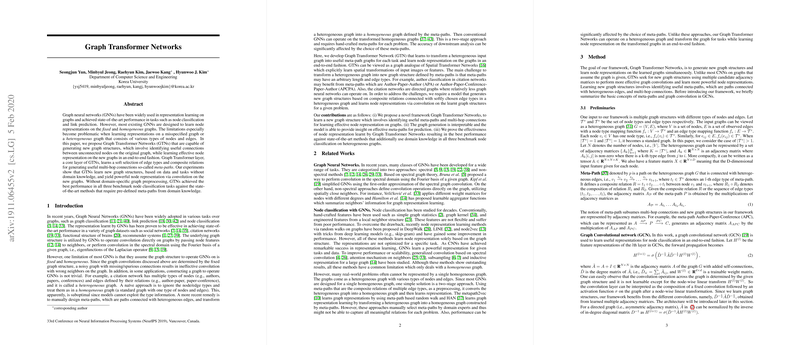Summary of "Graph Transformer Networks"
The paper "Graph Transformer Networks" by Seongjun Yun, Minbyul Jeong, Raehyun Kim, Jaewoo Kang, and Hyunwoo J. Kim introduces a novel approach to learning node representations on heterogeneous graphs through the design and implementation of Graph Transformer Networks (GTNs). The authors address a significant limitation in existing Graph Neural Networks (GNNs) that presuppose fixed and homogeneous graph structures.
Background and Motivation
Graph Neural Networks have become a predominant approach for tasks such as node classification, link prediction, and graph classification. These models typically operate under the constraints of fixed graph structures. However, real-world graphs are often heterogeneous, consisting of various types of nodes and edges. Traditional GNNs fail to exploit the richness of heterogeneous graphs fully, leading sometimes to suboptimal performance. To improve this, current approaches often employ manual, domain-specific meta-paths to convert heterogeneous graphs into homogeneous ones, yet this adds complexity and dependency on human expertise.
Graph Transformer Networks (GTNs)
GTNs advance beyond these limitations by learning to generate new graph structures and effectively performing node representation learning in an end-to-end fashion. The core component, the Graph Transformer layer, generates new graph structures by identifying useful multi-hop connections and meta-paths—a concatenation of edge types between nodes.
Methodology
The paper introduces the Graph Transformer Network architecture, which comprises multiple Graph Transformer layers. Each GT layer allows for the soft selection of adjacency matrices (representing different edge types in the graph) through a 1x1 convolutional layer. These selected edges are then combined to form new adjacency matrices representing meta-path graphs.
The authors employ a Graph Convolutional Network (GCN) over the newly generated adjacency matrices, capturing the convolution operations over these transformed graph structures. By stacking multiple GT layers, GTNs can learn meta-paths of varying lengths, adapting to the structure and complexity required for different datasets.
Key Contributions
- Meta-Path Generation: GTNs eliminate the need for manual meta-path definition by automatically learning and generating effective meta-paths for node classification tasks.
- Adaptivity and Interpretability: GTNs offer insights into the importance of different meta-paths through their attention mechanisms, which impact the weight of various adjacency matrices.
- Empirical Performance: GTNs demonstrate superior performance on benchmark heterogeneous graph datasets such as DBLP, ACM, and IMDB. Notably, GTNs achieved higher F1 scores than both traditional random walk methods and state-of-the-art GNN methods.
Results
The empirical evaluation highlights several notable outcomes:
- The integration of identity matrices in GT layers enables GTNs to adaptively determine the optimal length of meta-paths.
- In node classification tasks, GTNs show marked improvements over competitors, with F1 scores significantly higher across all tested datasets.
- GTNs facilitate the discovery of highly ranked meta-paths that are not predefined, thereby expanding the potential meta-path space considered during learning.
Implications and Future Directions
The implications of GTNs are substantial both in theory and practice. Theoretically, they establish an advanced methodology for end-to-end learning of node representations on heterogeneous graphs without relying on domain knowledge for preprocessing. Practically, GTNs can be incorporated with various GNN architectures, potentially enhancing performance in diverse applications such as recommender systems, social network analysis, and bioinformatics.
Future research could explore the synergy between GT layers and different GNN mechanisms beyond GCNs to gauge broader effectiveness. Additionally, applying GTNs to tasks such as link prediction, graph classification, and other network analysis tasks could provide further validation and reveal new capabilities of this approach.
Conclusion
Graph Transformer Networks represent a sophisticated advancement in GNN research, effectively overcoming the limitations of fixed and homogeneous graph structures. By generating and utilizing meta-paths dynamically and end-to-end, GTNs substantially improve node representation learning and classification tasks on heterogeneous graphs. This work sets the stage for expanded exploration and application across various domains requiring advanced graph-based learning methodologies.
